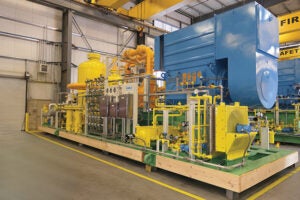Two companies who recently announced they are creating what they consider North America’s largest behind-the-meter (BTM) deployment of energy storage technology have said they plan to expand the service, providing a long-term solution for controlling costs and promoting energy sustainability for businesses.
Executives of the two companies—Honeywell and NRStor C&I—told POWER in a Sept. 23 interview at North America Smart Energy Week (NASEW) in Salt Lake City, Utah, that they see the market for their service expanding as power generation continues to become more decentralized.
The Honeywell-NRStor collaboration is one of several distributed power generation projects being highlighted at NASEW this week, for both energy storage and solar power. More than 700 companies are showcasing their products and services.
NRStor and Honeywell on Sept. 20 announced the launch of their Experion Energy Program, offering energy storage as a service to commercial and industrial customers. NRStor and Honeywell plan to develop and operate 300 MW of battery energy storage systems (BESS) in the U.S. and Canada starting early next year. The companies said they would operate the systems remotely and “provide customers with electricity cost savings, improved sustainability and resiliency.”
“The first 90 megawatts are earmarked for the Ontario [Canada] market early next year,” Moe Hajabed, CEO of Toronto, Ontario-based NRStor C&I, told POWER. “There’s a big market for energy storage in Ontario for cost savings, putting battery storage systems at customer sites. This battery energy storage system can reduce a customer’s cost of electricity, primarily by [reducing] demand charges. There’s a cost aspect, an environmental aspect, and a community aspect.”
Hajabed in announcing the program last week said, “This BTM deployment alone matches North America’s total energy storage deployments in 2018. This collaboration brings Honeywell’s operational excellence, precise equipment and construction to NRStor’s projects and expands the customer base that can take advantage of our energy solutions. This also creates an opportunity for other developers to fund and implement their projects through NRStor’s platform.”
The companies said the BESS will be supported by two remote operations centers that use artificial intelligence-based peak prediction and value stack optimization algorithms. The centers will automatically start the battery systems, with a goal to maximize savings for C&I customers. Control technologies from Honeywell will enable battery dispatch and support network security and cybersecurity protection.
‘Efficient and Sustainable’
“Our operations platform makes it easier to anticipate and manage demand and energy generation in today’s complex energy ecosystem,” said Eren Ergin, general manager, Renewable Energy and Distributed Assets, Honeywell Process Solutions. “Honeywell’s battery energy storage systems, software solutions and outcome-based performance guarantees will help end users optimize their operations and realize significant savings. Together with NRStor, we look forward to making industrial operations across North America more efficient and sustainable.”
Transparency Market Research, an Albany, New York-based consultancy and research organization, last week said of the energy storage as a service (ESaaS) market: “Energy storage systems are expected to become a crucial element of power management systems, due to peak demands frequently changing with time of the day and season. Energy storage as a service guarantees reduction in the most expensive hours of electric demand for building owners, thereby lowering electricity bills at no cost.”
Hajabed said exactly that about the NRStor/Honeywell system: “Our overall objective, with no capital outlay from the customer, is to provide energy storage as a service.”
NRStor “knows the commercial and industrial market,” Ergin told POWER, noting the companies’ services are complementary. “We see this model expanding. When you look at today’s market, deregulated and decentralized, it’s different from back in the day when you had the utility selling power to customers. Today you have multiple players managing demand and supply. We think with our operations platform, we can optimize the operations of these commercial and industrial customers. More and more you see the distributed assets producing the power. [C&I customers] are looking at asset owners like NRStor to come in and manage the service, manage storage on the demand side, and provide a long-term solution based on certain outcomes. And it’s important for the technology provider to have skin in the game.”
Ergin said the platform can handle several tasks. “The whole idea is to put different models on top of it,” he said. “Solar plus storage, wind plus storage. The platform can do energy management, and supervisory control, for DERMS (distributed energy resources management systems), VPP (virtual power plants), all of this is in one single platform. We start with the immediate asset, the energy storage, and add more capabilities as we go along.”
Hajabed concurred. “This can help businesses meet sustainability targets and capture more revenue from the value stack, with non-wire alternatives.”
Ergin echoed the sentiments of several of the speakers at the Salt Lake City event who touted the future of energy storage.
“This is the beginning,” he said, “and it’s going to gain traction.”
—Darrell Proctor is a POWER associate editor (@DarrellProctor1, @POWERmagazine).









